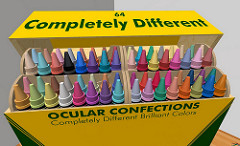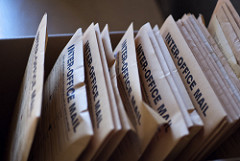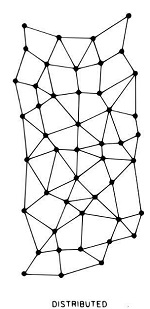If it’s a common refrain in your company that nobody can find anything on the file server or in the document management system, you are not alone. In many cases a company believes this is because they have a digital document organization problem or possibly the lack of a document czar.
Just because a company is not staffed entirely with former librarians doesn’t mean that a lack of organization is the only problem. There may be other factors at play, like for instance, rapid growth or a string of acquisitions. However, what’s really missing might be a document collection strategy.
Documents come into the organization in many ways – documents created internally, email, downloads, thumb drives and there is still paper. Your document management solution needs to have multiple ways to collect or ingest… Millennia Group Blog
We are all different
It’s no surprise that no two businesses are exactly alike and certainly no two employees are either. Our differences, along with the options provided by technology and changing circumstances, create a tremendous number of possible outcomes as it relates to information creation. This is especially true of information in the form of documents.
Every day in every business, employees are creating documents, searching for documents, receiving new documents and sharing documents with others. It’s imperative that the information makes sense, otherwise errors are made and time is wasted. But since we are all different, don’t be surprised at how someone else defines what a document is and in what form it’s delivered.
Document management systems (“DMS”) have to be about more than just finding documents, they have to be tools to help organize and… It’s not so simple
At some point every business probably feels a bit undervalued or unappreciated by customers or maybe by the markets. This may or may not be justified, but we’ve all been there. Over the years we have gained a deep understanding and appreciation for one group of businesses in particular that might feel this way – manufacturers.
There is tremendous complexity in the manufacturing business model of sourcing parts, labor and materials, making something out of that and then selling and servicing that product. Then there are also government regulations and customer compliance requirements to factor in. There are highly complex software applications that help keep the cost of that seemingly simple widget at $2.00. It’s really not so simple.
It starts with design, which generates drawings and a parts list. Bids for the parts… Do you have a complete picture?
It happens every day in our professional lives, we need information to make decisions or to complete tasks. To assist us in this effort we try to use our memory, the internet and information stored away in filing cabinets, desk drawers and computers.
Sometimes decisions or tasks are completed quickly from a single source of information. For instance, “was customer order 12345 invoiced?” – you can easily look it up in “the system”. This becomes more complex if the question simply expands to “and was it correct?”. Just like that you need much more information to come to the correct decision. It would be nice if there was only one place to get the complete picture.
The task of confirming the invoice can be a challenge. A manufacturing business or a service business will… In documents we trust, data not so much
Some day in the future it is plausible that paper documents in the business world will disappear. Electronic documents, however, in the form of PDF’s, Word files or Excel spreadsheets, will continue to exist. In fact, it will be a very long time before documents, and the content of the documents, cease to be important in the business world.
Technology has enabled simple processes or transactions to occur entirely with online forms and direct data entry. But there are still many instances where the content in a complex document becomes the data for accounting or ERP systems or documents. It is easy to see what was keyed in, but In Documents we trust.
Some business processes are being converted to an entirely form based process where the concept of a document doesn’t pertain. Take… Artificial Intelligence – Getting to Know You
How will artificial intelligence (“AI”) impact our world? There are knowledgeable people talking up the potential positive uses of AI and there are knowledgeable people voicing concern over the potential problems. On the positive side are articles generally oriented towards business efficiency gains, of which IBM’s Watson is a widely seen example.
Many companies are looking for a better way to help manage the explosive growth files and documents and they are hoping that AI and Watson can benefit them. The rate of growth is exponential and that is creating increased user search times and poor results accuracy – inefficient. AI might help users find the information that they are looking for, but Watson is going to have to get to know each user and know each user very well first.
Finding the right… Folders and paperclips, the original workflow tools
I don’t think I would like to be in the folder, inter-office envelope, paper clip or staple businesses. They had a great run. They served a very good purpose. But it’s time to move on to new forms of workflow. Yes, that’s right, paper clips, folders and envelopes were the first workflow tools.
Paper clips and staples separated documents into relevant parts. Folders and envelopes kept the collection of information together as it moved through the company for decision making purposes. Plenty of business decisions still rely on a collection of data and documents. So where have all the folders and paper clips gone? To digital workflow packages, which are the new tools for business process.
Some business processes can be very simple and decisions can easily be made with limited information. For instance,… Why is the mustard in the fruit drawer?
Have you ever found a jar of mustard in the fruit drawer of your refrigerator? How about the Penske file in the folder labeled Clients D-E? Let’s face it, there are those of us that are very organized and there are others that aren’t. This could be at home or at the office and it can be both frustrating and in the case of the office, costly.
We were recently asked if there is an optimal company size that dictates when it’s time to use an electronic document management system (EDMS) rather than a file storage solution like a network drive? I would say as soon as you find the mustard in the fruit drawer, it’s time. However, there are several factors that should be taken into consideration when considering the need for…
Technology goggles make work flow
The first thing that comes to mind when you hear about workflow is most likely order and process. There is validity in that thought. Workflow is intended to deliver efficiency and cost saving by using defined order and automated process. Defining what the process should be is the tricky but necessary part and it’s the fun part. Yes, fun. When you dig in and people realize how many time wasting tasks can be eliminated, you can feel the joy. So how do you re-connect the dots to create an effective digital workflow and really make work flow? Put on your technology goggles and look at the process.
The first step is to have the people involved in the process document how the process works. This will initially result in a small number of… Blockchain vs Digital Signatures
Bitcoin continues to make news and inroads into the world of finance. Two of the basic technologies that drive Bitcoin include blockchain and peer to peer computing. These two concepts are relatively understandable. Blockchain uses a distributed ledger, which is essentially a list that is shared across many computers (peer to peer). Because many computers contain a time-stamped replica of the data, it is very difficult, and expensive to hack or change the data in a fraudulent way – and its encrypted.
These concepts are moving into other areas such as smart contracts. However, these contracts are not documents as that term is generally understood. The smart contract is essentially a perfectly known set of conditions and data, that when met, results in a payment or action. The contract is essentially data points;…
Active vs Final – Revisited
The good thing about this blog is that I don’t really need to have answers. That is especially good since I am re-visiting the discussion about working documents versus final documents. It comes up in most every discussion about effective document management – how do I have one system that provides the functionality that I need for both working documents and final documents.
Recall from our earlier post about how creators of working documents tend to like fast and simple – a system where the user can create any collection of folders and subfolders to suit their needs and drag and drop files at will. A user of final documents requires structure and certainty because having quick access to the right documents gets the job done. However, at some point the documents…
The Next Big Thing
I participated in a webinar recently sponsored by Realcomm, an organization devoted to the advancement of technology for the commercial real estate industry. It was about the future and hype verses reality. My contribution was squarely on the reality side as I described how our real estate clients gain efficiency by using workflow to automate document oriented business processes.
You might think, “do we still have documents?” The answer in my world and the foreseeable world of our Fortune 5000 clients is, Yes. Documents may not be in paper form any longer, but documents of some type (spreadsheet, PDF contract, etc.), are the support for data and todays decisions. But to see the future, the next big thing, you need to believe in the internet of things (IoT), artificial intelligence (AI) and virtual…
Keeping it simple is not always the answer
Recently we helped a client convert a small amount of paper documents related to a one time transaction into PDFs. The PDFs would simply be in a folder and viewed or emailed as needed. To keep it simple the files could be named in a structured format, ie. “ABCCo-Contract-060116-Brazil-Engine-D-JF.pdf”. Most of that short hand is clear except the “D” is for diesel engines and that the Sales Rep was John Franklin? Seemed simple enough and so we proceeded based on the clients requirements.
In this case, the volume of documents was small, but the documents had a significant amount of descriptive information that could be captured. Each piece of information could be captured in a document management system database and ready for user searches. For example, find all contracts for Brazil or all…
Make my day – delete those records
Records retention and records management are very important principles in dealing with corporate information. Records management being the overall guide book for employees on to how to store and classify information. It is also about proper management of that information including legal holds (don’t destroy if litigation is in process), access to information and records retention.
Records retention is basically an information destruction plan based on business or legal requirements. A business doesn’t necessarily want the burden of securing confidential, but outdated information for ever – ie. former patient records. Creating a records management policy and records retention schedule requires a lot of effort and yet the actual deletion of records is a very difficult step to take. Here are some thoughts on how to feel better about pulling the trigger.
First, you need… Clutter of a different kind
The existence of duplicate documents and files is commonplace in companies of all sizes. There is the email with a document attachment that was sent to five people, each of whom downloaded the file. There is a file on someone’s desktop that they copied from the network. There is a copy in the cloud. You get the picture and you probably live this picture daily.
What can prevent this from happening? Does it really even matter? Companies seem to be surviving just fine, so what would be the cost benefit for an actual solution? Unless your company is a company of one, you will likely not find a perfect solution, but a combination of tactics will lower the frustration. And yes, it does matter and it will be worth it.
Companies can use de-duplication… 













